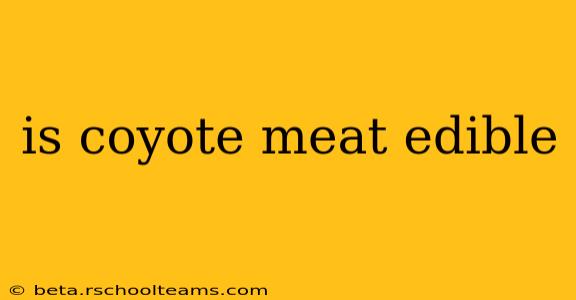The question of whether coyote meat is edible is a complex one, sparking debate among hunters, survivalists, and culinary adventurers. While technically edible, several factors significantly influence its palatability and safety for consumption. This guide will delve into the practical aspects, safety concerns, and ethical considerations surrounding eating coyote meat.
Is Coyote Meat Safe to Eat?
Yes, coyote meat is edible, but that doesn't automatically equate to "safe" or "delicious." The safety primarily hinges on proper handling and preparation:
Parasites and Disease:
Coyotes, like other wild animals, can carry parasites and diseases that are transmissible to humans. These include Trichinella (a roundworm causing trichinosis), Echinococcus (a tapeworm), and various bacteria. Thorough cooking to an internal temperature of 165°F (74°C) is crucial to eliminate these risks. Improperly cooked coyote meat poses a significant health hazard.
Location and Diet:
The coyote's diet and geographic location impact the safety of its meat. Coyotes that feed on garbage or contaminated sources are more likely to carry harmful bacteria or parasites. Coyotes in areas with known environmental contamination also pose a higher risk. Knowing the area where the coyote was harvested is crucial for assessing potential contamination.
Handling and Processing:
Proper handling and processing are paramount. Wear gloves when handling the carcass to avoid contact with potentially harmful bacteria or parasites. Field dressing should be conducted hygienically, minimizing contamination. Prompt refrigeration or freezing after processing is essential to prevent bacterial growth.
Taste and Texture of Coyote Meat
Describing the taste of coyote meat is subjective. Many compare it to lean venison or dog meat, with descriptions ranging from gamey and slightly tough to surprisingly tender and flavorful, depending on the animal's age and diet. Proper preparation is key to enhancing its flavor and texture. Many hunters prefer to use it in stews, chili, or jerky, methods that tenderize tougher cuts.
Culinary Uses:
While not a staple in most cuisines, resourceful individuals have found ways to incorporate coyote meat into their diets:
- Jerky: The lean nature of coyote meat makes it suitable for jerky, a method of preservation that also enhances its flavor.
- Stews and Chili: Tougher cuts benefit from slow cooking in stews or chili, where they tenderize and contribute to the overall flavor profile.
- Ground Meat: Coyote meat can be ground and used in various dishes similar to ground beef or venison.
Ethical and Legal Considerations
Hunting coyotes is subject to legal regulations varying by location and season. Check your local hunting regulations before pursuing coyotes for consumption. Ethical hunting practices, ensuring a clean kill and respectful treatment of the animal, are also essential considerations.
Conclusion
While coyote meat is technically edible, its consumption involves risks that necessitate caution. Thorough cooking, careful handling, awareness of potential contaminants, and compliance with local regulations are crucial. The decision to consume coyote meat is a personal one, involving considerations of safety, ethical hunting, and culinary preferences. Always prioritize safety and responsible consumption.
